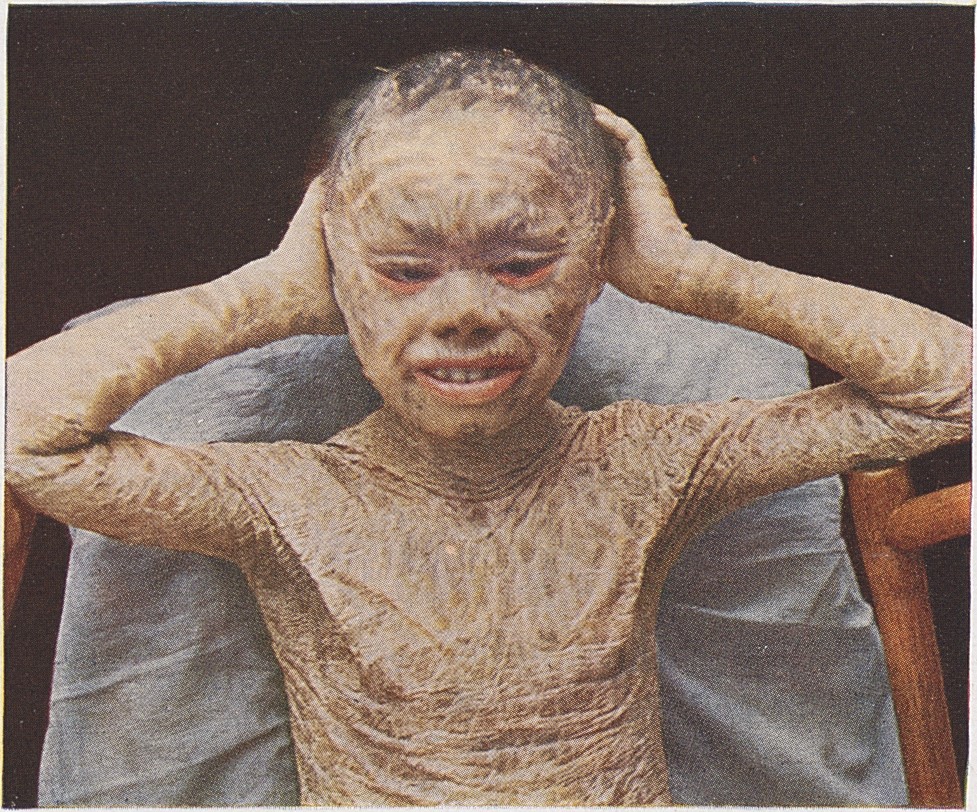Lamellar ichthyosis

Editor-In-Chief: Prab R Tumpati, MD
Obesity, Sleep & Internal medicine
Founder, WikiMD Wellnesspedia &
W8MD medical weight loss NYC and sleep center NYC
| Lamellar ichthyosis | |
|---|---|

| |
| Synonyms | Nonbullous congenital ichthyosiform erythroderma |
| Pronounce | |
| Specialty | Dermatology |
| Symptoms | Dry skin, scaling, erythroderma |
| Complications | Overheating, dehydration, skin infections |
| Onset | Birth |
| Duration | Lifelong |
| Types | |
| Causes | Genetic mutation in TGM1, ABCA12, ALOX12B, ALOXE3, NIPAL4 |
| Risks | |
| Diagnosis | Clinical examination, genetic testing |
| Differential diagnosis | Ichthyosis vulgaris, X-linked ichthyosis, Netherton syndrome |
| Prevention | |
| Treatment | Emollients, keratolytics, retinoids |
| Medication | Acitretin, isotretinoin |
| Prognosis | Variable, depends on severity |
| Frequency | 1 in 200,000 to 300,000 |
| Deaths | N/A |
A rare genetic skin disorder
Lamellar ichthyosis is a rare genetic skin disorder characterized by the presence of large, dark, plate-like scales covering the body. It is one of the forms of ichthyosis, a group of disorders that cause dry, scaly skin. Lamellar ichthyosis is present at birth and persists throughout life.
Pathophysiology[edit]
Lamellar ichthyosis is caused by mutations in genes responsible for skin barrier function. The most common gene associated with this condition is the TGM1 gene, which encodes the enzyme transglutaminase 1. This enzyme is crucial for the formation of the cornified cell envelope, a structure that provides a barrier to water loss and protects against environmental damage. The defective enzyme leads to impaired skin barrier function, resulting in excessive water loss and the accumulation of scales. The scales are typically large, dark, and plate-like, giving the skin a rough texture.
Clinical Features[edit]

Individuals with lamellar ichthyosis are often born with a collodion membrane, a shiny, waxy layer of skin that sheds within the first few weeks of life. After the membrane is shed, the characteristic scaling becomes apparent. The scales are usually most prominent on the trunk, limbs, and scalp, but can affect the entire body. Other features may include:
- Ectropion, or outward turning of the eyelids
- Eclabium, or outward turning of the lips
- Hypohidrosis, or reduced ability to sweat, leading to heat intolerance
- Palmoplantar keratoderma, thickening of the skin on the palms and soles
Diagnosis[edit]
Diagnosis of lamellar ichthyosis is primarily clinical, based on the characteristic appearance of the skin. Genetic testing can confirm the diagnosis by identifying mutations in the TGM1 gene or other associated genes.
Management[edit]
Management of lamellar ichthyosis focuses on alleviating symptoms and improving skin barrier function. Treatment options include:
- Regular use of emollients and moisturizers to hydrate the skin
- Keratolytic agents, such as salicylic acid or urea, to help remove scales
- Retinoids, which can reduce scaling and improve skin texture
Patients should also take measures to avoid overheating due to impaired sweating.
Prognosis[edit]
Lamellar ichthyosis is a lifelong condition, but with appropriate management, individuals can lead normal lives. The severity of symptoms can vary, and some individuals may experience improvement with age.
See also[edit]
Ad. Transform your life with W8MD's Budget GLP-1 injections from $75


W8MD offers a medical weight loss program to lose weight in Philadelphia. Our physician-supervised medical weight loss provides:
- Weight loss injections in NYC (generic and brand names):
- Zepbound / Mounjaro, Wegovy / Ozempic, Saxenda
- Most insurances accepted or discounted self-pay rates. We will obtain insurance prior authorizations if needed.
- Generic GLP1 weight loss injections from $75 for the starting dose.
- Also offer prescription weight loss medications including Phentermine, Qsymia, Diethylpropion, Contrave etc.
NYC weight loss doctor appointmentsNYC weight loss doctor appointments
Start your NYC weight loss journey today at our NYC medical weight loss and Philadelphia medical weight loss clinics.
- Call 718-946-5500 to lose weight in NYC or for medical weight loss in Philadelphia 215-676-2334.
- Tags:NYC medical weight loss, Philadelphia lose weight Zepbound NYC, Budget GLP1 weight loss injections, Wegovy Philadelphia, Wegovy NYC, Philadelphia medical weight loss, Brookly weight loss and Wegovy NYC
|
WikiMD's Wellness Encyclopedia |
| Let Food Be Thy Medicine Medicine Thy Food - Hippocrates |
Medical Disclaimer: WikiMD is not a substitute for professional medical advice. The information on WikiMD is provided as an information resource only, may be incorrect, outdated or misleading, and is not to be used or relied on for any diagnostic or treatment purposes. Please consult your health care provider before making any healthcare decisions or for guidance about a specific medical condition. WikiMD expressly disclaims responsibility, and shall have no liability, for any damages, loss, injury, or liability whatsoever suffered as a result of your reliance on the information contained in this site. By visiting this site you agree to the foregoing terms and conditions, which may from time to time be changed or supplemented by WikiMD. If you do not agree to the foregoing terms and conditions, you should not enter or use this site. See full disclaimer.
Credits:Most images are courtesy of Wikimedia commons, and templates, categories Wikipedia, licensed under CC BY SA or similar.
Translate this page: - East Asian
中文,
日本,
한국어,
South Asian
हिन्दी,
தமிழ்,
తెలుగు,
Urdu,
ಕನ್ನಡ,
Southeast Asian
Indonesian,
Vietnamese,
Thai,
မြန်မာဘာသာ,
বাংলা
European
español,
Deutsch,
français,
Greek,
português do Brasil,
polski,
română,
русский,
Nederlands,
norsk,
svenska,
suomi,
Italian
Middle Eastern & African
عربى,
Turkish,
Persian,
Hebrew,
Afrikaans,
isiZulu,
Kiswahili,
Other
Bulgarian,
Hungarian,
Czech,
Swedish,
മലയാളം,
मराठी,
ਪੰਜਾਬੀ,
ગુજરાતી,
Portuguese,
Ukrainian